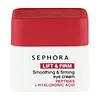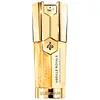What's inside
What's inside
 Key Ingredients
Key Ingredients

No key ingredients
 Benefits
Benefits

 Concerns
Concerns

 Ingredients Side-by-side
Ingredients Side-by-side

Water
Skin ConditioningCoco-Caprylate/Caprate
EmollientPropanediol
SolventC10-18 Triglycerides
EmollientGlycerin
HumectantCetyl Alcohol
EmollientGlyceryl Stearate Se
EmulsifyingSodium Polyacrylate
AbsorbentCI 77891
Cosmetic ColorantHydroxyethyl Acrylate/Sodium Acryloyldimethyl Taurate Copolymer
Emulsion StabilisingSynthetic Fluorphlogopite
Tocopheryl Acetate
AntioxidantCaprylyl Glycol
EmollientHydrolyzed Vegetable Protein
Skin ConditioningHydroxyacetophenone
AntioxidantSodium Benzoate
MaskingSodium Hyaluronate
HumectantSodium Phytate
Polysorbate 60
EmulsifyingSorbitan Isostearate
EmulsifyingTin Oxide
AbrasiveTocopherol
AntioxidantWater, Coco-Caprylate/Caprate, Propanediol, C10-18 Triglycerides, Glycerin, Cetyl Alcohol, Glyceryl Stearate Se, Sodium Polyacrylate, CI 77891, Hydroxyethyl Acrylate/Sodium Acryloyldimethyl Taurate Copolymer, Synthetic Fluorphlogopite, Tocopheryl Acetate, Caprylyl Glycol, Hydrolyzed Vegetable Protein, Hydroxyacetophenone, Sodium Benzoate, Sodium Hyaluronate, Sodium Phytate, Polysorbate 60, Sorbitan Isostearate, Tin Oxide, Tocopherol
Water
Skin ConditioningGlycerin
HumectantPropanediol
SolventButylene Glycol
HumectantAlcohol
AntimicrobialEthylhexyl Stearate
EmollientPentylene Glycol
Skin ConditioningPropylene Glycol Dicaprylate/Dicaprate
EmollientTapioca Starch
Royal Jelly
Coco-Caprylate/Caprate
EmollientCellulose
AbsorbentSoybean Glycerides
EmollientHydroxyethyl Acrylate/Sodium Acryloyldimethyl Taurate Copolymer
Emulsion StabilisingSteareth-21
CleansingSynthetic Fluorphlogopite
Mel
EmollientBis-Behenyl/Isostearyl/Phytosteryl Dimer Dilinoleyl Dimer Dilinoleate
EmollientStearyl Alcohol
EmollientCI 77891
Cosmetic ColorantButyrospermum Parkii Butter Unsaponifiables
Skin ConditioningSorbitol
HumectantCetyl Alcohol
EmollientMel Extract
MoisturisingSteareth-2
EmulsifyingParfum
MaskingChlorphenesin
AntimicrobialCaprylyl Glycol
EmollientPolyglyceryl-10 Stearate
Skin ConditioningMangifera Indica Seed Butter
Skin ConditioningPolyglycerin-4
HumectantWater, Glycerin, Propanediol, Butylene Glycol, Alcohol, Ethylhexyl Stearate, Pentylene Glycol, Propylene Glycol Dicaprylate/Dicaprate, Tapioca Starch, Royal Jelly, Coco-Caprylate/Caprate, Cellulose, Soybean Glycerides, Hydroxyethyl Acrylate/Sodium Acryloyldimethyl Taurate Copolymer, Steareth-21, Synthetic Fluorphlogopite, Mel, Bis-Behenyl/Isostearyl/Phytosteryl Dimer Dilinoleyl Dimer Dilinoleate, Stearyl Alcohol, CI 77891, Butyrospermum Parkii Butter Unsaponifiables, Sorbitol, Cetyl Alcohol, Mel Extract, Steareth-2, Parfum, Chlorphenesin, Caprylyl Glycol, Polyglyceryl-10 Stearate, Mangifera Indica Seed Butter, Polyglycerin-4
Ingredients Explained
These ingredients are found in both products.
Ingredients higher up in an ingredient list are typically present in a larger amount.
Caprylyl Glycol is a humectant and emollient, meaning it attracts and preserves moisture.
It is a common ingredient in many products, especially those designed to hydrate skin. The primary benefits are retaining moisture, skin softening, and promoting a healthy skin barrier.
Though Caprylyl Glycol is an alcohol derived from fatty acids, it is not the kind that can dry out skin.
This ingredient is also used as a preservative to extend the life of products. It has slight antimicrobial properties.
Learn more about Caprylyl GlycolCetyl Alcohol is a fatty alcohol. Fatty Alcohols are most often used as an emollient or to thicken a product.
Its main roles are:
Though it has "alcohol" in the name, it is not related to denatured alcohol or ethyl alcohol.
The FDA allows products labeled "alcohol-free" to have fatty alcohols.
Learn more about Cetyl AlcoholCi 77891 is a white pigment from Titanium dioxide. It is naturally found in minerals such as rutile and ilmenite.
It's main function is to add a white color to cosmetics. It can also be mixed with other colors to create different shades.
Ci 77891 is commonly found in sunscreens due to its ability to block UV rays.
Learn more about CI 77891Coco-Caprylate/Caprate is created from fatty coconut alcohol, caprylic acid, and capric acid.
It is a lightweight emollient. Emollients create a thin barrier on the skin to trap moisture in. This helps keep your skin hydrated and soft.
Once applied, Coco-Caprylate/Caprate is absorbed quickly and leaves a silky feel.
Coco-Caprylate/Caprate may not be fungal acne safe.
Learn more about Coco-Caprylate/CaprateGlycerin is already naturally found in your skin. It helps moisturize and protect your skin.
A study from 2016 found glycerin to be more effective as a humectant than AHAs and hyaluronic acid.
As a humectant, it helps the skin stay hydrated by pulling moisture to your skin. The low molecular weight of glycerin allows it to pull moisture into the deeper layers of your skin.
Hydrated skin improves your skin barrier; Your skin barrier helps protect against irritants and bacteria.
Glycerin has also been found to have antimicrobial and antiviral properties. Due to these properties, glycerin is often used in wound and burn treatments.
In cosmetics, glycerin is usually derived from plants such as soybean or palm. However, it can also be sourced from animals, such as tallow or animal fat.
This ingredient is organic, colorless, odorless, and non-toxic.
Glycerin is the name for this ingredient in American English. British English uses Glycerol/Glycerine.
Learn more about GlycerinThis is a synthetic polymer. It helps improve the texture of products by adding thickness and gel-like feel.
It is also an emulsifer, meaning it prevents ingredients such as oil and water from separating. It also helps evenly disperse other ingredients.
Propanediol is an all-star ingredient. It softens, hydrates, and smooths the skin.
It’s often used to:
Propanediol is not likely to cause sensitivity and considered safe to use. It is derived from corn or petroleum with a clear color and no scent.
Learn more about PropanediolSynthetic Fluorphlogopite is the synthethic version of mica. It consists of fluorine, aluminum and silicate.
Synthetic Fluorphlogopite is used to add volume to products.
It is considered non-irritating on the skin.
Learn more about Synthetic FluorphlogopiteWater. It's the most common cosmetic ingredient of all. You'll usually see it at the top of ingredient lists, meaning that it makes up the largest part of the product.
So why is it so popular? Water most often acts as a solvent - this means that it helps dissolve other ingredients into the formulation.
You'll also recognize water as that liquid we all need to stay alive. If you see this, drink a glass of water. Stay hydrated!
Learn more about Water